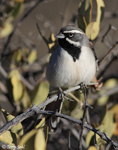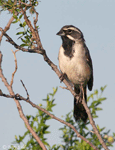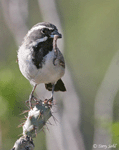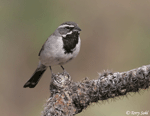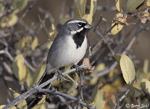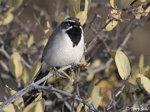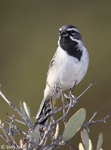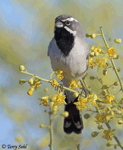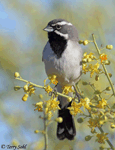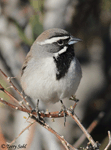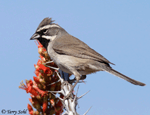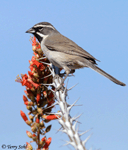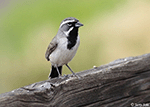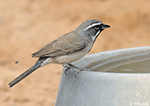| Length: 5.5 inches | Wingspan: 8.5 inches | Seasonality: Extremely rare visitor |
| ID Keys: Black throat and mask, white eyebrow, white whisker, grayish-brown upperparts, whitish underparts with grayish wash on the sides. | ||
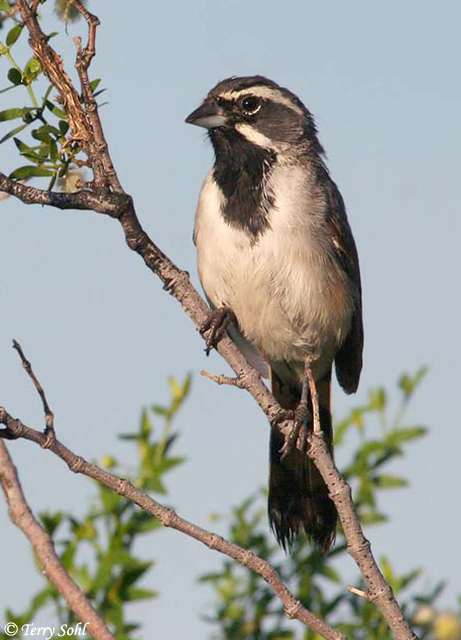 The Black-throated
Sparrow is primarily a bird of arid regions in the West, where they can be quite
common even in areas with very sparse vegetation. While not shy when
approached by humans, they do not adapt well to the intrusion of human
development in their native habitats. To ensure adequate water supplies
for young, timing of the nesting season usually coincides with the timing of
rains.
The Black-throated
Sparrow is primarily a bird of arid regions in the West, where they can be quite
common even in areas with very sparse vegetation. While not shy when
approached by humans, they do not adapt well to the intrusion of human
development in their native habitats. To ensure adequate water supplies
for young, timing of the nesting season usually coincides with the timing of
rains.
Habitat:
Can be found in a variety of dry open habitats, including quite barren salt flats with scattered bushes, sagebrush flats, grasslands with scattered cactii, and open pinyon-juniper woodlands.
Diet:
Feeds on insects and seeds, with the balance tipping towards insects in the summer and towards seeds in the winter. They will also eat green buds and fresh leaves when available, as well as fruits and berries. They can survive for long periods without water, drawing water from the insects and vegetation that they eat.
Behavior:
Mostly forages while running along the ground, although they will also forage in desert cactii and shrubs. Males will sing from high perches during the summer breeding season.
Song:
The song of a Black-throated Sparrow is two or three bell-like notes followed by a rapid trill. Calls of a Black-throated Sparrow include a ringing peek, often repeated incessently.
- Click here to hear the song of a Black-throated Sparrow1
- Click here to hear the peek call of a Black-throated Sparrow2
- Click here to hear interaction vocalizations of three Black-throated Sparrows3
Nesting:
Non-breeder in South Dakota. In their breeding range, Black-throated Sparrows nest in shrubs, typically within a foot or two of the ground. The nest is a small cup, constructed by the female and built of grasses, rootlets, and weed steams, and lined with hair and/or finer grasses. The female lays 2 to 4 eggs, and she alone incubates them. The young hatch after about 12 days, and fledge from the nest 10 to 12 days after hatching.
Migration:
Summers in much of the interior U.S. West. Winters in the Southwest U.S. and Mexico, where many birds are permanent residents.
Feeders:
On occasion, Black-throated Sparrows will visit feeder complexes for sunflower seeds and other offerings.
Similar Species:
Black-throated Sparrows could potentially be confused with other sparrow species found in their range:
- Sagebrush Sparrow - Sagebrush Sparrow could be found in similar habitat, and have a similar size and structure as a Black-throated Sparrow. However, they lack the namesake black throat of a Black-throated Sparrow. Sagebrush sparrow have a bold white eye-ring that's lacking from Black-throated Sparrow, while Black-throated Sparrow have a bold white eyebrow lacking from Sagebrush Sparrow.
- Black-chinned Sparrow - Black-chinned Sparrows are found in similar habitat and overlap in range with Black-throated Sparrows. However, while they share the trait of a black throat, it's much less extensive on a Black-chinned Sparrow. Black-chinned Sparrows are also more gray all over, unlike the much lighter underparts of a Black-throated Sparrow. Black-chinned Sparrows also lack the white-brow of a Black-throated Sparrow.
- Bell's Sparrow - Bell's Sparrow are similar to Sagebrush Sparrow, but with a limited range primarily in California and Baha California. They lack the black throat and bold white eyebrow of a Black-throated Sparrow. Conversely, Black-throated Sparrow lack the white eye-ring of a Bell's Sparrow.
 |
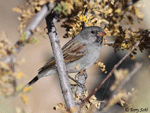 |
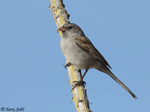 |
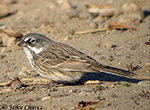 |
| Sagebrush Sparrow | Black-chinned Sparrow | Black-chinned Sparrow | Bell's Sparrow |
Conservation Status:
Increased development in desert habitat has reduced numbers in some locations. They do not adapt to a human presence quite as well as some other species. Systematic surveys (Christmas Bird Count, Breeding Bird Survey) over the last 40 years have shown a decline of over 60%. However, they are still found across a very broad geographic area and are common in parts of that range. The IUCN considers the Black-throated Sparrow to be a species of "Least Concern".
Interactive eBird Map:
Click to access an interactive eBird map of Black-throated Sparrow sightings
Further Information:
- Audubon Guide - Black-throated Sparrow
- WhatBird - Black-throated Sparrow
- BirdWeb - Black-throated Sparrow
Photo Information:
September 7th, 2006 -- Near Tucson, Arizona -- Terry Sohl
Additional Photos: Click on the image chips or text links below for additional, higher-resolution Black-throated Sparrow photos.
Audio File Credits:
- 1Paul Marvin. Recorded in Pima County, Arizona on August 2nd, 2019. Original recording and information available from xeno-canto.
- 2Frank Lambert. Recorded in Mesa County, Colorado on April 23rd, 2015. Original recording and information available from xeno-canto.
- 3Richard E. Webster. Recorded in Cochise County, Arizona on May 23rd, 2015. Original recording and information available from xeno-canto.
| Click on the map below for a higher-resolution view |
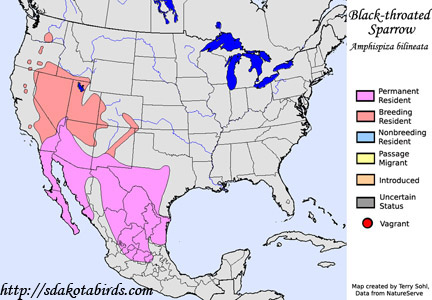 |
| South Dakota Status: Extremely rare visitor. The SDOU's "Birds of South Dakota" (2002) lists only one occurrence of the species in the state, photographed in Clay County in 1971. |
Additional Black-throated Sparrow Photos
Click for a higher-resolution version of these photos
